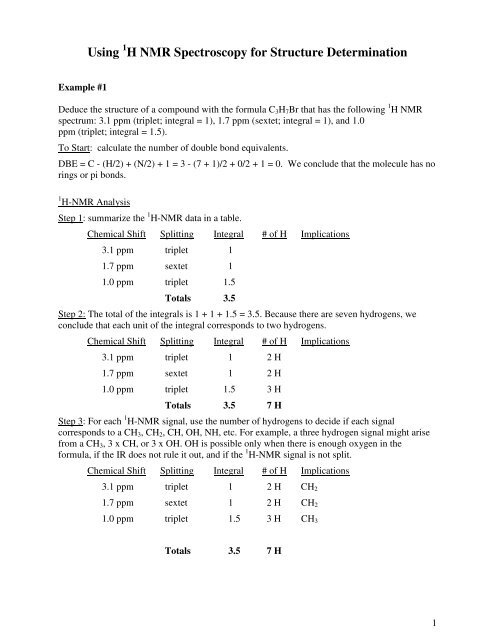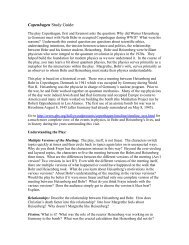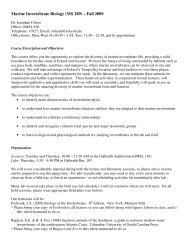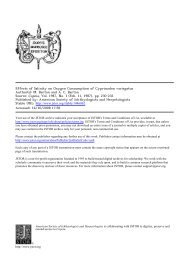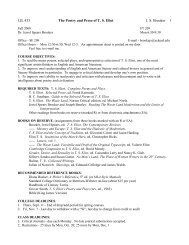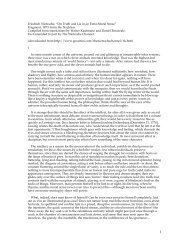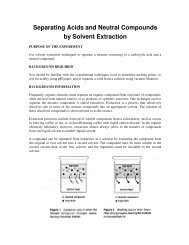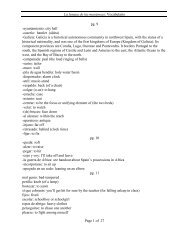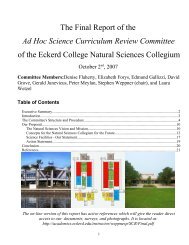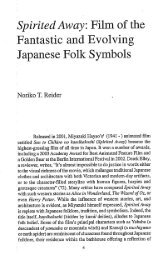Using H NMR Spectroscopy for Structure Determination
Using H NMR Spectroscopy for Structure Determination
Using H NMR Spectroscopy for Structure Determination
You also want an ePaper? Increase the reach of your titles
YUMPU automatically turns print PDFs into web optimized ePapers that Google loves.
Example #1<br />
<strong>Using</strong> 1 H <strong>NMR</strong> <strong>Spectroscopy</strong> <strong>for</strong> <strong>Structure</strong> <strong>Determination</strong><br />
Deduce the structure of a compound with the <strong>for</strong>mula C3H7Br that has the following 1 H <strong>NMR</strong><br />
spectrum: 3.1 ppm (triplet; integral = 1), 1.7 ppm (sextet; integral = 1), and 1.0<br />
ppm (triplet; integral = 1.5).<br />
To Start: calculate the number of double bond equivalents.<br />
DBE = C - (H/2) + (N/2) + 1 = 3 - (7 + 1)/2 + 0/2 + 1 = 0. We conclude that the molecule has no<br />
rings or pi bonds.<br />
1 H-<strong>NMR</strong> Analysis<br />
Step 1: summarize the 1 H-<strong>NMR</strong> data in a table.<br />
Chemical Shift Splitting Integral # of H Implications<br />
3.1 ppm triplet 1<br />
1.7 ppm sextet 1<br />
1.0 ppm triplet 1.5<br />
Totals 3.5<br />
Step 2: The total of the integrals is 1 + 1 + 1.5 = 3.5. Because there are seven hydrogens, we<br />
conclude that each unit of the integral corresponds to two hydrogens.<br />
Chemical Shift Splitting Integral # of H Implications<br />
3.1 ppm triplet 1 2 H<br />
1.7 ppm sextet 1 2 H<br />
1.0 ppm triplet 1.5 3 H<br />
Totals 3.5 7 H<br />
Step 3: For each 1 H-<strong>NMR</strong> signal, use the number of hydrogens to decide if each signal<br />
corresponds to a CH3, CH2, CH, OH, NH, etc. For example, a three hydrogen signal might arise<br />
from a CH3, 3 x CH, or 3 x OH. OH is possible only when there is enough oxygen in the<br />
<strong>for</strong>mula, if the IR does not rule it out, and if the 1 H-<strong>NMR</strong> signal is not split.<br />
Chemical Shift Splitting Integral # of H Implications<br />
3.1 ppm triplet 1 2 H CH2<br />
1.7 ppm sextet 1 2 H CH2<br />
1.0 ppm triplet 1.5 3 H CH3<br />
Totals 3.5 7 H<br />
1
Step 4: Use the n+1 rule and the observed splitting patterns to determine all the possibilities that<br />
would give the observed 1 H-<strong>NMR</strong> signals. Example: The 2H triplet at 3.1 ppm could be due to a<br />
CH2, or 2 CH groups. The CH2 or 2 x CH groups must have two neighbors, as the observed<br />
splitting pattern is a triplet. Keeping things simple, it would appear that the CH2 group has<br />
another CH2 group next to it; this accounts <strong>for</strong> the triplet. The sextet at 1.7 ppm must arise from<br />
a total of five neighboring hydrogens. Since a single carbon can’t have five hydrogens, there<br />
must be two different sets of hydrogens that sum to five; let’s use a CH3 and a CH2 group. We<br />
make record of this in the table. (In this table the underlined hydrogens correspond to the given<br />
chemical shift.) The triplet at 1.0 ppm is determined accordingly.<br />
.<br />
Chemical Shift Splitting Integral # of H Implication<br />
3.1 ppm triplet 1 2 H CH2 in CH2CH2<br />
1.7 ppm sextet 1 2 H CH2 in CH2CH2CH3<br />
1.0 ppm triplet 1.5 3 H CH3 in CH3CH2<br />
Totals 3.5 7H<br />
Step 5: We now sum up the atoms that are underlined. We do this as a check to make sure we<br />
have used all the hydrogens and to look <strong>for</strong> atoms that do not show up in the 1 H-<strong>NMR</strong> spectrum,<br />
such a COO portion of an ester.<br />
Chemical Shift Splitting Integral # of H Implication<br />
3.1 ppm triplet 1 2 H CH2 in CH2CH2<br />
1.7 ppm sextet 1 2 H CH2 in CH2CH2CH3<br />
1.0 ppm triplet 1.5 3 H CH3 in CH3CH2<br />
Totals 3.5 7H CH2 + CH2 + CH3 = C3H7<br />
Step 6: Atom Check. Look <strong>for</strong> unused atoms. Given <strong>for</strong>mula - atoms from 1 H-<strong>NMR</strong> or other<br />
sources such as IR = unused atoms. For this example: C3H7Br – C3H7 = Br. There<strong>for</strong>e 1 H-<strong>NMR</strong><br />
data accounts <strong>for</strong> all of the atoms in the <strong>for</strong>mula except the bromine. This bromine atom must be<br />
included when assembling the pieces.<br />
Step 7: DBE Check. Look <strong>for</strong> unused DBEs. DBEs calculated from <strong>for</strong>mula – DBE accounted<br />
<strong>for</strong> (by 1 H-<strong>NMR</strong>, etc.) = unused DBEs. In this example the <strong>for</strong>mula has no DBEs and the 1 H-<br />
<strong>NMR</strong> data does not require any DBEs, so there are no left over DBEs to consider when<br />
assembling the pieces.<br />
Step 8: List and assemble the pieces. At this point you’ve done 90% of the work. Now we<br />
assemble the pieces to come up with the final structure. The pieces suggested by the 1 H-<strong>NMR</strong><br />
data are:<br />
CH2 in CH2CH2<br />
CH2 in CH2 CH2CH3<br />
CH3 in CH3CH2<br />
Br<br />
2
Also include pieces suggested by other means such as IR data.<br />
There is often many ways to go about assembling the pieces in solving <strong>NMR</strong> spectroscopy<br />
problems. Use the clues provided by the spectra, such as coupling patterns. Sometimes trial and<br />
error is all that works. In this case, the middle fragment uses all three of the available carbons<br />
and fits with the other fragments as shown below.<br />
CH2 in CH2CH2<br />
CH2 in CH2 CH2CH3<br />
CH3 in CH2CH3<br />
The fragments have been reduced to CH3CH2CH2 and Br, which can only be assembled one way:<br />
CH3CH2CH2Br<br />
Step 9: Check to make sure the proposed structure is consistent with the original data, i.e.,<br />
chemical shift (use table), splitting, and integration. In this case, examine CH2 next Br: is the<br />
chemical shift consistent with what we expect?<br />
This process might seem long and unnecessarily complicated <strong>for</strong> such a simple molecule, but can<br />
be very useful in organizing your thoughts <strong>for</strong> more complex examples. The process becomes<br />
much faster with practice and a little bit of experience.<br />
Example #2:<br />
Deduce the structure of a compound with the <strong>for</strong>mula C9H12 that has the following 1 H <strong>NMR</strong><br />
spectrum: 7.40 – 7.02 ppm (multiplet, integral = 2.5); 2.57 ppm (triplet, integral = 1); 1.64<br />
ppm (sextet, integral = 1) and 0.94 ppm (triplet, integral = 1.5).<br />
To Start: calculate the number of double bond equivalents.<br />
DBE = C - (H/2) + (N/2) + 1 = 9 - (12)/2 + 0/2 + 1 = 4. We conclude that the molecule has<br />
either four double bonds or four rings, or some combination of the two. Given the number of<br />
carbon atoms, we suspect a benzene ring.<br />
1 H-<strong>NMR</strong> Analysis<br />
Step 1: summarize the 1 H-<strong>NMR</strong> data in a table.<br />
Chemical Shift<br />
7.40 to 7.02 ppm<br />
2.57 ppm<br />
1.64 ppm<br />
0.94 ppm<br />
Splitting<br />
multiplet<br />
triplet<br />
sextet<br />
triplet<br />
Totals<br />
Integral<br />
2.5<br />
1<br />
1<br />
1.5<br />
6<br />
# of H<br />
Implications<br />
3
Step 2: The total of the integrals is 1 + 1 + 1.5 + 2.5 = 6. Because there are 12 hydrogens, we<br />
conclude that each unit of the integral corresponds to two hydrogens.<br />
Chemical Shift<br />
7.40 to 7.02 ppm<br />
2.57 ppm<br />
1.64 ppm<br />
0.94 ppm<br />
Splitting<br />
multiplet<br />
triplet<br />
sextet<br />
triplet<br />
Totals<br />
Integral<br />
2.5<br />
1<br />
1<br />
1.5<br />
6<br />
# of H<br />
5<br />
2<br />
2<br />
3<br />
12<br />
Implications<br />
Step 3: Again, <strong>for</strong> each 1 H-<strong>NMR</strong> signal, use the number of hydrogens to decide if each signal<br />
corresponds to a CH3, CH2, CH, OH, NH, etc.<br />
Chemical Shift<br />
7.40 to 7.02 ppm<br />
2.57 ppm<br />
1.64 ppm<br />
0.94 ppm<br />
Splitting<br />
multiplet<br />
triplet<br />
sextet<br />
triplet<br />
Totals<br />
Integral<br />
2.5<br />
1<br />
1<br />
1.5<br />
6<br />
# of H<br />
5<br />
2<br />
2<br />
3<br />
12<br />
Implications<br />
Step 4: As be<strong>for</strong>e, use the n+1 rule and the observed splitting patterns to determine all the<br />
possibilities that would give the observed 1 H-<strong>NMR</strong> signals. Example: The 2H triplet at 2.57 ppm<br />
is most likely due to a CH2 bonded to another CH2 group, as the observed splitting pattern is a<br />
triplet. Determine the rest of table accordingly.<br />
Chemical Shift<br />
7.40 to 7.02 ppm<br />
2.57 ppm<br />
1.64 ppm<br />
0.94 ppm<br />
Splitting<br />
multiplet<br />
triplet<br />
sextet<br />
triplet<br />
Totals<br />
Integral<br />
2.5<br />
1<br />
1<br />
1.5<br />
6<br />
# of H<br />
5<br />
2<br />
2<br />
3<br />
12<br />
CH2<br />
CH2<br />
CH3<br />
C 6 H 5<br />
Implications<br />
C 6 H 5<br />
CH2 in CH2CH2<br />
CH2 in CH2CH2CH3<br />
CH3 in CH3CH2<br />
4
Step 5: We now sum up the atoms that are underlined. Check to make sure we have used all the<br />
hydrogens and to look <strong>for</strong> atoms that do not show up in the 1 H-<strong>NMR</strong> spectrum.<br />
Chemical Shift<br />
7.40 to 7.02 ppm<br />
2.57 ppm<br />
1.64 ppm<br />
0.94 ppm<br />
Splitting<br />
multiplet<br />
triplet<br />
sextet<br />
triplet<br />
Totals<br />
Integral<br />
2.5<br />
1<br />
1<br />
1.5<br />
6<br />
# of H<br />
5<br />
2<br />
2<br />
3<br />
12<br />
Implications<br />
CH2 in CH2CH2<br />
CH2 in CH2CH2CH3<br />
CH3 in CH3CH2<br />
C6H5 + CH2 + CH2 + CH3 =<br />
C9H12<br />
Step 6: Atom Check. Given <strong>for</strong>mula - atoms from 1 H-<strong>NMR</strong> or other sources such as IR =<br />
unused atoms. For this example: C9H12 – C9H12 = nothing. There<strong>for</strong>e 1 H-<strong>NMR</strong> data accounts <strong>for</strong><br />
all of the atoms in the <strong>for</strong>mula.<br />
Step 7: DBE Check. For this example the <strong>for</strong>mula has 4 DBEs and the 1 H-<strong>NMR</strong> data accounts<br />
<strong>for</strong> 4 DBE. No additional DBE.<br />
Step 8: List and assemble the pieces. The pieces suggested by the 1 H-<strong>NMR</strong> data are:<br />
CH2 in CH2CH2<br />
CH2 in CH2 CH2CH3<br />
CH3 in CH3CH2<br />
The fragments have been reduced to CH3CH2CH2 and mono-substituted benzene ring with a total<br />
of two open valences (places to make a bond). There is only one way to assemble pieces. Final<br />
structure is propylbenzene.<br />
CH 2 CH 2 CH 3<br />
C 6 H 5<br />
Step 9: Check to make sure the proposed structure is consistent with the original data, i.e.,<br />
chemical shift (use table), splitting, and integration, and IR data (if given).<br />
5
Example #3:<br />
Deduce the structure of a compound with the <strong>for</strong>mula C4H8O2 that has the following 1 H <strong>NMR</strong><br />
spectrum: 3.67 ppm (singlet, integral = 1.5); 2.32 ppm (quartet, integral = 1); 1.15 ppm (triplet,<br />
integral = 1.5).<br />
To Start: calculate the number of double bond equivalents.<br />
DBE = C - (H/2) + (N/2) + 1 = 4 - (8)/2 + 0/2 + 1 = 1. The molecule has either one double bond<br />
or one ring.<br />
1 H-<strong>NMR</strong> Analysis<br />
Chemical Shift<br />
3.67 ppm<br />
2.32 ppm<br />
1.15 ppm<br />
Splitting<br />
singlet<br />
quartet<br />
triplet<br />
Totals<br />
Integral<br />
1.5<br />
1<br />
1.5<br />
4<br />
# of H<br />
Atom Check: C4H8O2 (given <strong>for</strong>mula) – C3H8 (from 1 H-<strong>NMR</strong>) = CO2.<br />
3<br />
2<br />
3<br />
8<br />
Implications<br />
CH3<br />
CH2 in CH2CH3<br />
CH3 in CH3CH2<br />
CH3 + CH2 + CH3 = C3H8<br />
DBE Check: The 1 H-<strong>NMR</strong> data does not account <strong>for</strong> the one DBE. Now suspect an ester<br />
functional group, since have CO2 remaining and one DBE. Being able to make inferences like<br />
this is very important and requires practice.<br />
6
List and Assemble the Pieces:<br />
CH 3<br />
CH 2 in CH 2 CH 3<br />
O<br />
CH 3 in CH 3 CH 2 ester<br />
We have an ethyl group and a methyl group, each with an empty valence. Since there are two<br />
empty valences on the ester functional group, the ethyl and methyl groups can go on either end<br />
of the ester; thus, there are two possible ways to assemble the fragments:<br />
O<br />
H 3 C C<br />
O CH 2 CH 3<br />
C<br />
CH 3 CH 2<br />
A B<br />
O<br />
O<br />
C<br />
O CH 3<br />
Use chemical shift and splitting patterns to distinguish between these. Compound A would have<br />
a singlet integrating <strong>for</strong> three at ~2.2 ppm <strong>for</strong> the CH3 group bonded to the carbonyl carbon.<br />
Compound A would also have a quartet at ~3.8 ppm <strong>for</strong> the CH2 group bonded to the ether<br />
oxygen. Our <strong>NMR</strong> data is not consistent with these predicted chemical shifts and splitting<br />
patterns. We conclude, there<strong>for</strong>e, that compound B is the correct answer.<br />
H 3 C C<br />
Predict:<br />
O<br />
singlet @ 2.2 ppm<br />
Predict:<br />
quartet @ 3.8 ppm<br />
Final Check <strong>for</strong> Consistency:<br />
O CH 2 CH 3<br />
CH 3 CH 2<br />
A B<br />
O<br />
C<br />
Predict: triplet @ ~0.9 ppm<br />
Observe: triplet @ 1.15 ppm<br />
Observe quartet @ 2.32 ppm<br />
Predict: quartet @ 2.2 ppm<br />
O CH 3<br />
Predict: singlet @ 3.8 ppm<br />
Observe: singlet @ 3.67 ppm<br />
Compound B should have a singlet integrating <strong>for</strong> 3 protons at about 3.8 ppm; we have a singlet<br />
at 3.67 ppm. We should have a quartet integrating <strong>for</strong> two protons at ~2.2 ppm; we have such a<br />
signal at 2.32. We predict a triplet integrating <strong>for</strong> three protons at 0.9; we observe a triplet at<br />
1.15 ppm. The data is consistent with the proposed structure; it is not consistent with compound<br />
A.<br />
7


